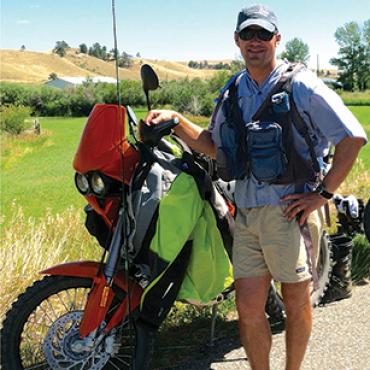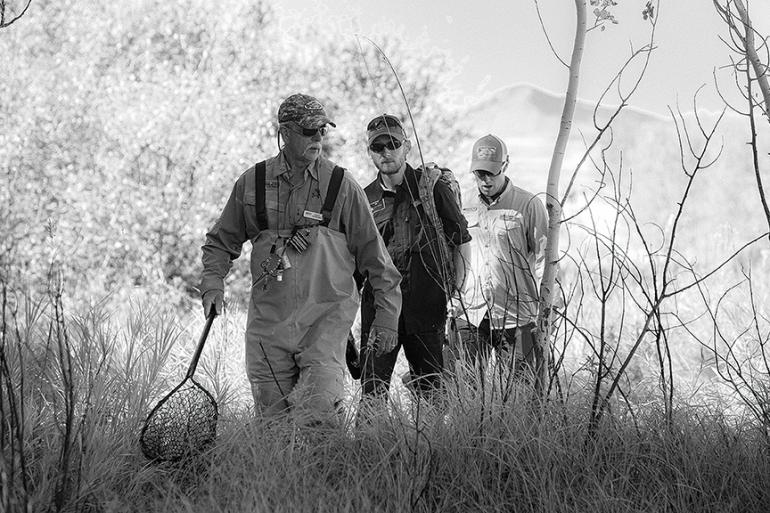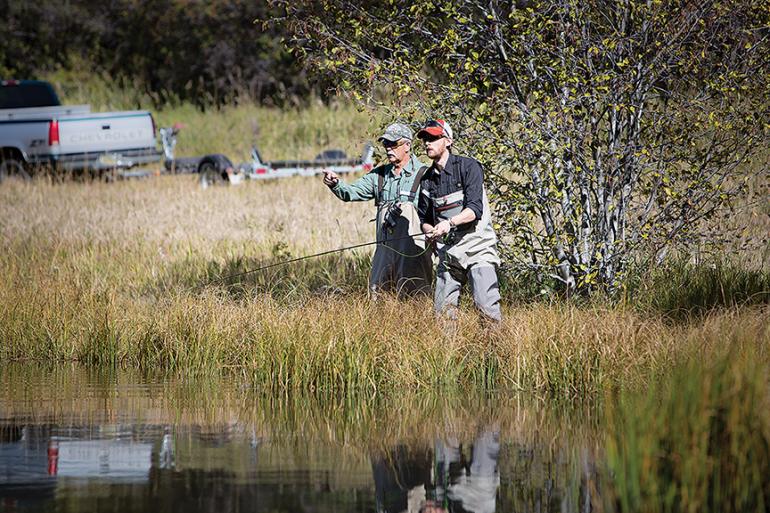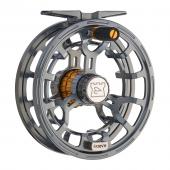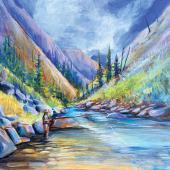Dave's Angle
Q&A with a local legend.
If you love fly fishing, imagine moving to the Gallatin Valley in 1970—that’s when legendary angler, outfitter, and conservationist Dave Kumlien settled into a life filled with “mountains and moving water.” Since then, he’s spent every bit as much time learning how to conserve fish and their habitats as he has learning to how to catch them. And he spends a whole lot of time learning how to catch them. Dave struck me as a veteran of interviews; he had more to say than I had space to write. Here’s a taste.
Jimmy Lewis: Where are you from originally?
Dave Kumlien: Wisconsin. When I was a kid, the Northwoods of Wisconsin was a wild place. We had a cabin on a lake there. I did a lot of rowing around that lake. There were creeks and rice marshes and wildlife everywhere. I did a lot of fishing for bass and panfish. Simply put, I spent a lot of time in the outdoors. I loved ornithology and birds were abundant in those marshes.
JL: When did you move to Bozeman and what are the biggest changes you’ve seen since?
DK: 1970. These days, there are a lot more people fishing. Do I decry the crowding? No, I don’t. Get out early. Beat the crowds. That’s why God made coffee and alarm clocks. Funny thing is, many of the new people don’t notice. Clients aren’t upset. So largely the problem is coming from your own perception. But there is less civility and communication out there. People need to talk on the river and not be afraid of being some kind of a moron. Try to communicate and work together out there so that everyone has a better day.
JL: When did you start fishing professionally? Outfitting. Troutfitters?
DK: I got my guide’s license in 1975, my outfitter’s license in 1978 (#281). Forty-one years of guiding and 38 years of outfitting. I owned Montana Troutfitters until 1990, at which time I sold the shop to Josh Standish and remained on board in a consulting role and assisting as an outfitter. I was lucky with the timing and getting into business here.
JL: When did you get serious about conservation and how did you become involved with Trout Unlimited (TU)?
DK: Conservation is a family tradition passed down to me. It was a theme in our family and a conservation ethic is something I was instilled with from an early age. Locally, I could see there were threats to the things that I loved to do. So I got involved. My wife Karen’s dad was a TU grassroots national trustee which helped me move in that direction. Formulating my conservation ethos toward trout fishing in southwest Montana were FWP biologists Dick Vincent and Fred Nelson. These were the guys who promoted the further development of wild fisheries instead of stocking programs on rivers like the Madison. It was an incredibly controversial idea at the time. These guys took me under their wing.
JL: What are today’s major threats?
DK: Mining is certainly one of them. The Smith River copper mine is a train wreck waiting to happen. The permitting process is flawed. It is not based upon precedent. No matter how much of a public outcry, the permitting process can still go through. There must be fundamental changes made to this.
JL: What about Warriors & Quiet Waters?
DK: I’m one of the founders of Warriors & Quiet Waters. TU is now giving veterans a free membership. We want to keep them fishing and help them get involved in a community. No one has done more mentoring of veterans and fishing than I have. I am very familiar now with the warrior ethos. Mission first. Never leave a fallen comrade. Never admit defeat. Veterans have been trained in leadership and mission. This ethic makes them great for conservation. Veterans and TU are a perfect alliance.
JL: Do you have any words of wisdom for the younger generation of guides?
DK: Guide when you’re young. Also, try to keep in mind that guiding is about more than body counts and fish sizes; it’s about the experience and the education. See yourself as a teacher, not just a fish-catcher.
JL: Philosophically and technically, how does one guide and outfit in a manner that is conducive to both the health of the resource and the satisfaction of the client?
DK: I don’t think that guiding and outfitting fly fishermen for trout conflicts with having conservation ethics or having a goal of conserving and protecting the resource. From a practical standpoint, these days, nearly ALL clients practice catch-and-release. The survival rate for trout caught and properly released is quite high and typically doesn’t cause an increase in the mortality rate that occurs naturally. Mother Nature is harsh, and she will kill 20-25% of the trout population by natural causes, and it has been shown that C&R fishing doesn’t increase this natural rate. I mentioned this to you before that as guides, we have an extraordinary relationship with our clients. We are their mentors and teachers, and they take our advice freely. Our clients are often very intelligent folks and highly successful professionals, and yet, they’ll take fishing advice from us as if we were their most trusted advisors. With this relationship, we are able to instill in them our conservation ethics.
JL: Most people have very little trouble getting involved in the sport of fly fishing nowadays. Men and women of any age can walk into a fly shop as neophytes and leave fully outfitted and ready to head to the river. But what about getting involved in coldwater conservation—how easy it that? Is there anything more the industry could be doing in order to facilitate this process? What are some approaches an angler can take to get involved?
DK: I think it is quite easy to get involved in coldwater conservation. I work for North America’s leading coldwater conservation organization, Trout Unlimited, and we have over 400 chapters around the country. I encourage my clients to find a local TU Chapter and get involved. If you don’t have a TU chapter nearby, there are other fine national conservation organizations that work to protect these same resources including the Nature Conservancy, American Rivers, and the Wilderness Society, and there are almost uncountable numbers of local nonprofits working on specific drainages like the Gallatin Watershed Council. As to the fly-fishing industry promoting conservation, I think, for the most part, we do a reasonable job. Many of the industry leaders such as Orvis, Simms, Patagonia, Scientific Anglers, and others promote good conservation. Could they do more? Sure, but I think the fly-fishing industry “gets it.”
JL: When Whirling Disease came to the forefront of the problems facing regional fisheries, it’s my understanding that you became the point man in leading the efforts to address this problem. What was this experience like for you and what is the current situation regarding Whirling Disease? Is it still a major issue?
DK: When it was announced in December of 1994 by MT Fish, Wildlife, and Parks that WD was the cause of the nearly 90% decline in the rainbow trout population in the Madison River, a group of Bozeman conservationists, Trout Unlimited members, and avid trout anglers got together to talk about the need for research into whirling disease. At the time, very little was known about WD. I was a member of this group which included Bozeman attorney Tom Anacker, former executive director of Colorado TU Jim Belsey, Chris Francis, owner of C. Francis and Company and a lead fisheries staff person for Ted Turner, and Dr. Karl Johnson, world-renowned human virologist. We started the Whirling Disease Foundation (WDF) with a goal of organizing WD research to answer the many unanswered questions about WD. The WDF was very effective at organizing fish and wildlife agencies and research institutions to work on WD. We held the first WD Symposium in Bozeman in 1995, and went on to host a total of ten such meetings. I was told my Dr. Jim Winton who ran a fisheries research center in Seattle that he had never seen a fish-health issue receive the sort of effective attention that came to bear on the WD problem. Personally, it was very rewarding to see the efforts of the WDF be so effective. In a relatively short period, the WDF helped fill in many of the “knowledge gaps” regarding WD, and helped develop some “best-management practices” to help reduce impacts of improperly managed hatcheries and stocking programs that helped spread WD, initially. While we have moved on to the next environment, fish-health train wreck, WD remains a serious issue for coldwater fish health professionals. The impact of WD has not been as devastating as was initially feared, but problems remain for impacted rivers and populations including the Madison River and the Yellowstone River, and unfortunately, despite our collective attention having turned to other issues, we have not seen the end of WD problems.
JL: I know this is a very controversial and politically-charged issue, but let’s try to remove the issue of climate change from the political arena for a moment and address it. For one, in your 40+ years on the rivers of southwest Montana, have you noticed any environmental changes that suggest climate change is occurring? Should anglers, guides, and outfitters who fish coldwater fisheries be concerned about this issue?
DK: My position on climate change is that it does appear that our climate is changing, that winters are becoming milder, weather patterns are changing, runoff comes earlier, and is not of as long a duration. What I am not convinced of is that this climate change is “man-caused”, and that by adapting policies and practices that would take us back toward the stone age, we’ll reverse or eliminate the causes of climate change. I once had a conversation with Dr. Jack Horner, the world famous paleontologist at the Museum of the Rockies and Montana State University, that helped frame my view of climate change. Jack pointed out that over the history of the earth, we’ve experienced many climate changes, many of which were far more dramatic, severe, and impactful than what we are experiencing now. So, should we be concerned? Yes, we should be. What can we do? I believe that sound conservation policies to protect our trout, salmon, and steelhead are very important, and habitat protection and improvement programs will help trout, salmon, and steelhead populations deal with these changes.
JL: Recently there is a massive effort underway in the region to eliminate non-native fauna and flora of every kind. Rivers and streams teeming with non-native rainbows and browns are being poisoned to make way for native species like cutthroat and grayling. Is this a good idea?
DK: I believe it is important to protect native species from being displaced by non-natives. However, I am also an AVID sport fisherman, and before we start randomly killing off our amazing non-native sport fishing populations like our rainbow and brown trout populations, I have to be convinced this is necessary to protect the native species. In some locations, it doesn’t seem worthwhile to kill robust non-native sport fishing trout populations that are not displacing existing native trout populations. An extensive conversation I once had with noted trout ecologist Dr. Robert Behnke has stuck with me, and that was Dr. Behnke telling me that the brown and rainbows that inhabit, say, the Madison have become genetically unique, wild trout. I guess I don’t see why we would kill these robust wild trout populations off? So, the elimination of ALL of our non-native sport fish makes absolutely no sense at all, and I strongly and vehemently oppose this approach.
JL: I was immediately struck by your mentioning several times throughout our interview how much you still love to fish. Having been a guide myself, I have seen burnout among friends and colleagues to the degree that some of these people have lost their passion for fishing. Yet, here you are having been guiding for over 40 years and the fire still burns. What’s the secret?
DK: No secret, really, I just love fly fishing for trout. I love the fish and the environs they inhabit. There’s scientific evidence that shows that spending time on the stream lowers your blood pressure and helps relieve stress. I believe I told you the story of me asking the group of disabled vets who had gone fishing with their wives and with me on a beautiful lake near the Henry’s Fork. When I asked them if they had, at ANY TIME during the day, thought of their injuries, the horrors of the wars they had fought in, or their personal troubles, TO A PERSON, THEY SAID NO! This is why I fly fish for trout. When I am on the river, I NEVER think about anything but the fishing and the beautiful places I am fishing.
Dave Kumlien: By the Numbers
Years fishing: 66
Years fishing in MT: 43
Years guiding: 41
Years affiliated with TU: 39
Family generations involved with TU: 4
Days on the water annually: 90
Wounded warriors introduced to fly fishing: ~900
Fishing students: thousands

